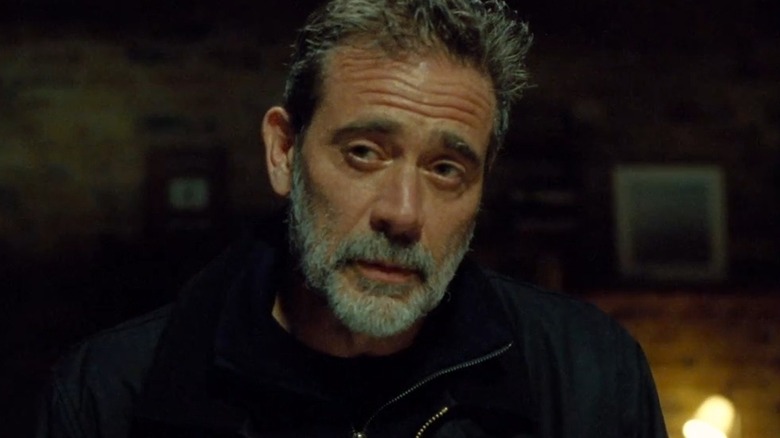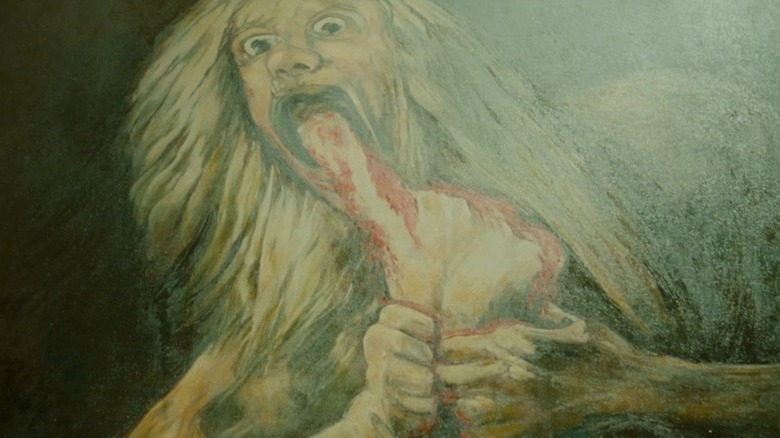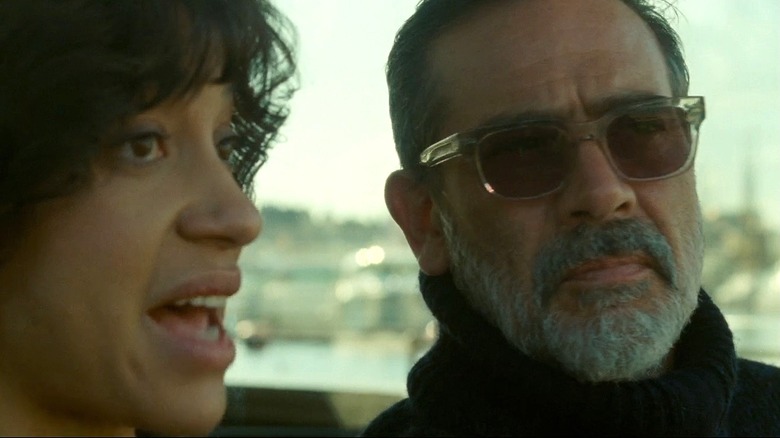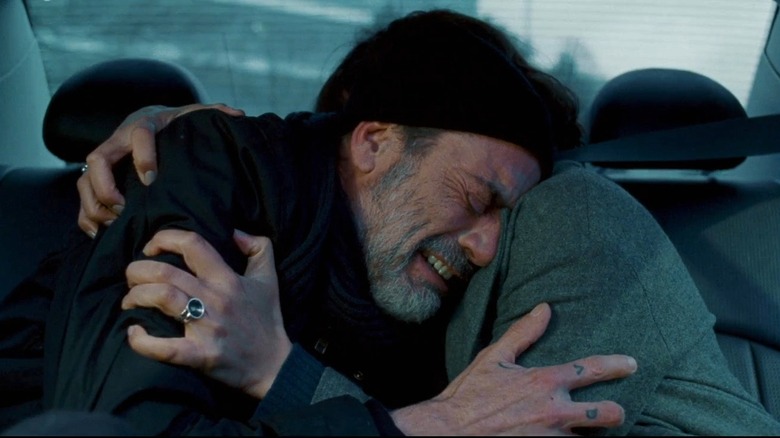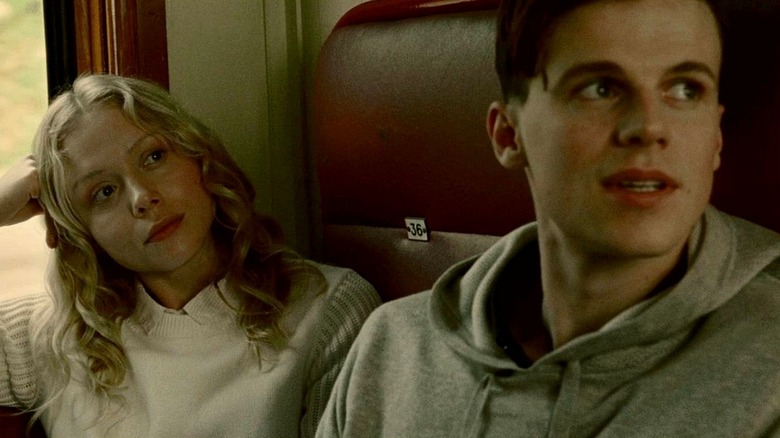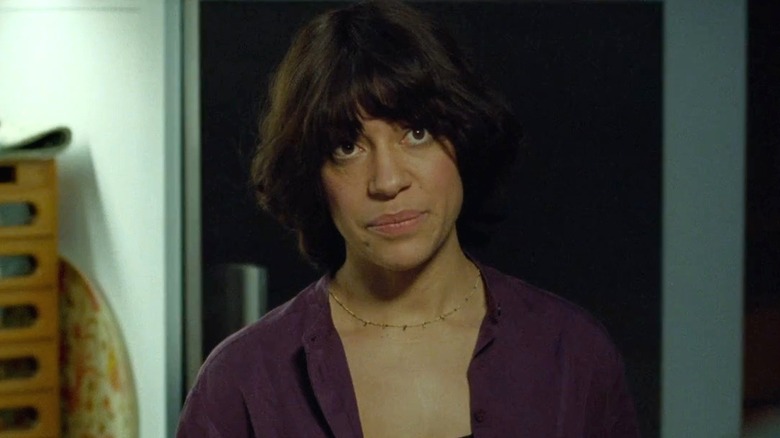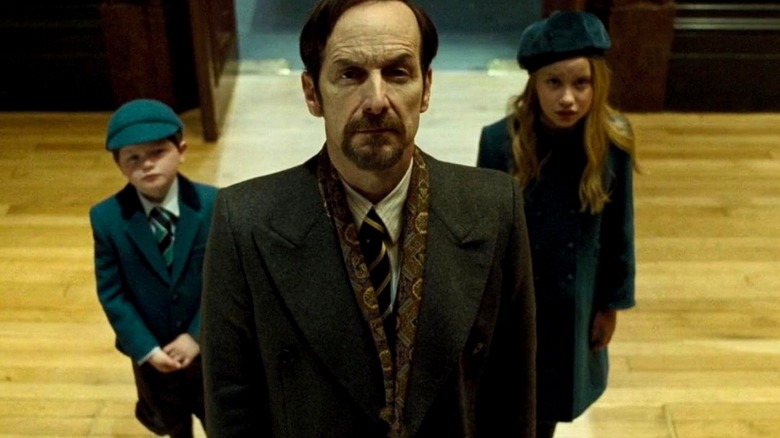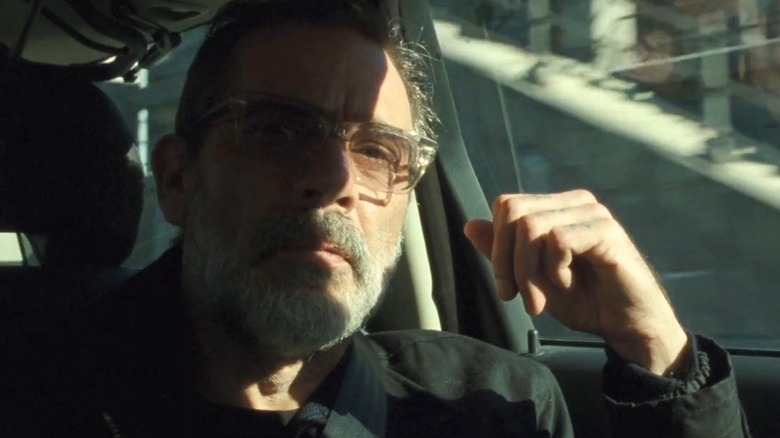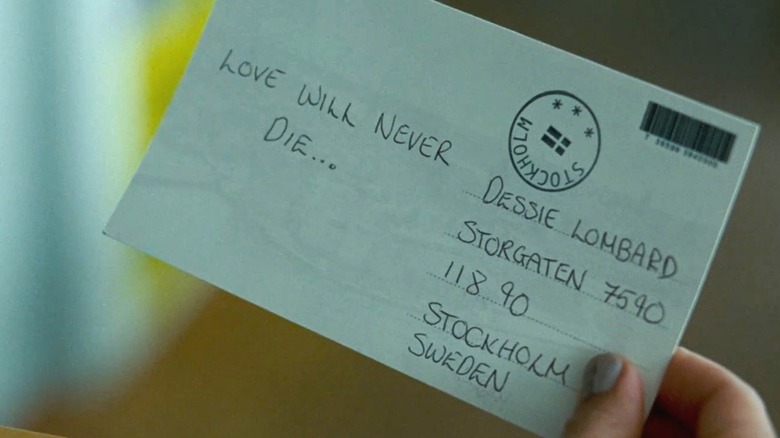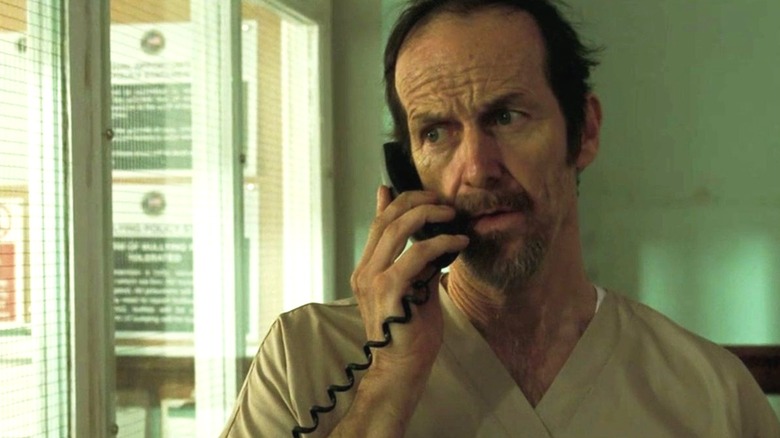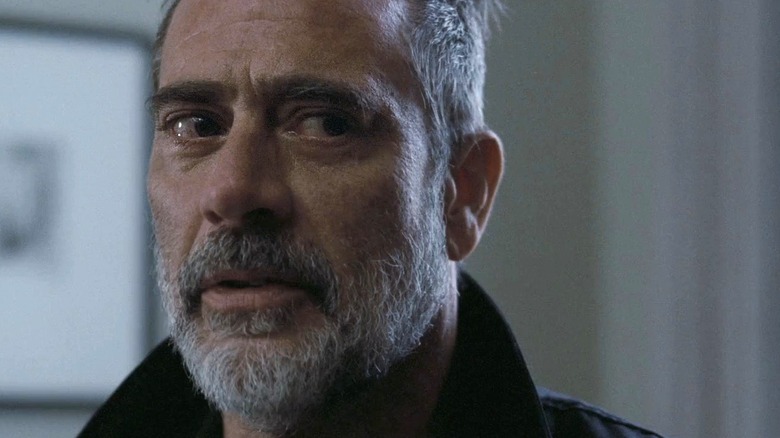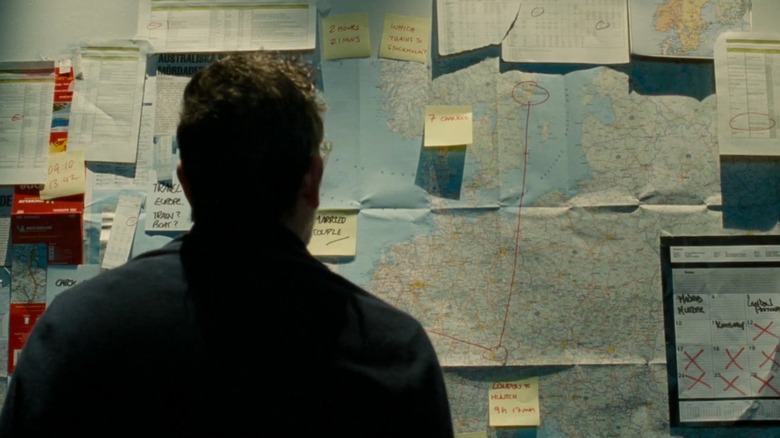The Ending Of The Postcard Killings Explained
2020's "The Postcard Killings" begins with the gruesome murder of a couple on holiday in Europe, and from there, the story only gets darker. Based on a novel written by James Patterson and Liza Marklund, unlike some book adaptations that ruined their source material, the film might actually be an improvement on the original. It's just as tightly plotted as the source material, but the performances from Jeffrey Dean Morgan, Naomi Battrick, and Denis O'Hare, of "American Horror Story" fame, add a whole new level to the original story.
"The Postcard Killings" didn't debut to critical acclaim, but thanks to its endlessly twisting narrative, it's one of the more underappreciated thrillers you'll find on Netflix. While it might be a little light on strongly written characters, the film's plot will keep you on the edge of your seat throughout the entire experience. Every time you think you have the killers figured out, the movie introduces another unexpected detail that transforms your entire understanding of the villains. From the first twist to the cliffhanger ending, "The Postcard Killings" takes the audience on a rollercoaster ride, and we're here to help make sense of everything that happened in it.
What you need to remember about the plot of The Postcard Killings
Jacob Kanon (Morgan) is an American detective who finds himself in Europe after his daughter and her husband are murdered while on their honeymoon. After identifying their bodies, Jacob utilizes his own investigative skills to hunt down the person who killed them. Despite some initial pushback from the local authorities, Jacob eventually discovers that his daughter's murder is linked to a series of homicides that have taken place across the continent.
Jacob starts working with local cops, his ex-wife Valerie (Famke Janssen), and a reporter named Dessie Lombard (Cush Jumbo) to piece together clues gathered from various crime scenes throughout Europe. The killers stage the bodies of their victims like famous art pieces, and they also send postcards with cryptic messages to local journalists — hence the movie's title.
As Jacob's investigation progresses, the film cuts from time to time to various scenes showing another young couple, Slyvia (Naomi Battrick) and Mac (Ruairi O'Connor) Randolph, who appear to be traveling on some kind of vacation or honeymoon. About halfway through the story, however, we learn that despite their outward appearance, these two are the killers. Jacob and his cohorts manage to take the couple into custody, but when they're unable to prove that the Randolphs are connected to the murders, they're forced to let them go.
What happened at the end of The Postcard Killings
Despite having no solid evidence, Jacob is convinced that the Randolphs are the ones who killed his daughter. As he digs deeper into their past, he learns that "Sylvia" and "Mac" are completely fake identities. Jacob asks his ex-wife to call in some favors, and she's able to help him figure out that the suspects are actually siblings named Marina and Simon Haysmith. Even more shocking is the revelation that the pair were raised by a wealthy, violent father, Simon Haysmith Senior (O'Hare), who's currently in prison for killing his wife, the killers' mother.
By talking with Mr. Haysmith, Jacob and his friends are able to piece together a disturbing picture of who Marina and Simon are. The siblings were manipulated by their father before ultimately being rejected by him because they fell in love with each other. Mr. Haysmith punished his children for being romantically involved, but that only inspired them to reunite as adults and use their father's passion for art and violence to send him a very pointed message.
Having finally pieced together the story behind their murder spree, Jacob asks Dessie to help lure the Haysmiths out of hiding. She publishes a story about their relationship, and they decide to make her the final victim in their sadistic art project. Jacob manages to save Dessie from the Haysmiths, but he kills Simon in the process and seemingly lets Marina escape. At the very end of the film, Jacob and Dessie learn that the Haysmith siblings were adopted; Mr. Haysmith lied to them both for reasons only he understands. In the final scene of the movie, Marina calls her father in prison, but the audience isn't allowed to hear their conversation.
What was the real reason behind the killers' M.O.?
Even though Marina and Simon claim that their murders are fueled by love, the scenes they create are incredibly disturbing. The two of them save severed body parts from those they murder to sew onto future victims, "sculpting" them into images reminiscent of Renaissance paintings. If the two are trying to communicate something about their love, then they might not realize just how ghastly the message they're sending really is.
In reality, the grotesque murders had more to do with Marina's and Simon's relationship with their father than with their own romance. Mr. Haysmith was an avid art lover, and his endless lectures about the art world gave Marina and Simon the motivation for their methods. Mr. Haysmith also beat the children and their mother, which is almost certainly why the siblings tried to communicate with him through violence rather than pure artistic expression.
Because Marina and Simon had such a twisted childhood, they're unable to view the world the way other people do. They truly believe that they need to win their father's approval in order to live happy lives, and they feel an artistically minded murder spree is the only way to convince him of just how powerful and important their love for each other is.
Were Marina and Simon really siblings?
The final few minutes of "The Postcard Killings" add a whole new layer of tragedy to the story. When the movie first reveals that Marina and Simon are siblings, it's hard not to feel disgusted. The two of them obviously had a terrible childhood, and there's no doubt that their father's abuse had something to do with their murderous turn. That said, the fact that they've spent their entire lives pursuing an incestuous relationship makes it seem like maybe they both had a natural inclination toward the profane.
Except it turns out that isn't true at all. The movie almost offhandedly reveals that Marina and Simon aren't actually related by blood. Jacob and Dessie just briefly talk about how the two of them were adopted from completely separate families, but they don't dwell on the darkest implication of that story. Mr. Haysmith set up his own adopted children to believe they were blood-related and to fall in love while simultaneously implanting in them a fascination for art and a proclivity for violence. Despite not getting nearly as much screen time as his adopted children, this twist makes it clear that Mr. Haysmith is the movie's true villain.
How does Dessie's role in the story change the meaning?
Jacob and his grief might be the driving forces behind the investigation, but Jacob would never be able to solve the case without Dessie. An American expatriate who lives in Sweden and works as an investigative journalist, she's able to lend her expertise to Jacob's hunt. Dessie is able to find and piece together clues alongside the best agents Interpol has to offer, but in the end, it's her writing skills that really save the day.
Together, Jacob and Dessie figure out that Marina and Simon are in love, and they hatch a plot to get the killers to expose themselves. They realize that the siblings, in their own twisted way, are seeking some kind of understanding through their killings. Dessie writes a lengthy piece about Marina's and Simon's misdeeds, but throughout her article, she manages to express a sympathetic understanding of the love they feel for each other.
Dessie's writing ultimately connects with Marina and Simon on an emotional level. Simon is all but ready to stop the killings after reading Dessie's piece, which tells us that he's being manipulated by Marina in the same way that Mr. Haysmith manipulated them both. In the end, it's a deeply human desire for understanding and compassion that exposes Marina and Simon as serial killers.
Did Mr. Haysmith orchestrate the killings?
Mr. Haysmith is at the center of "The Postcard Killings," even if he doesn't get his own hands dirty. Mr. Haysmith adopted Marina and Simon and raised them as his own children, but he didn't do so out of the goodness of his heart. We learn that he instead divided his time between abusing his children and indoctrinating them with his own fascination with violence and high art. At the end of the movie, we finally learn that he lied to his adopted children and led them to believe they were related to each other by blood, but we never get an opportunity to really dig into his motivation for creating this fiction.
The movie frames Mr. Haysmith as a shadowy "man behind the curtain" figure who's somehow responsible for everything despite the fact that he's trapped in prison for the entire film, with no way to have directly organized all the murders that Marina and Simon commit. He obviously raised the children with the intention of turning them into psychopaths like himself, and he's probably delighted to learn how much blood his children have on their hands. That said, there's no real evidence that he had a good way to communicate with his children or to set up any of the killings from his prison cell.
What will Jacob and Dessie do next?
Jacob and Dessie didn't know each other before the events of "The Postcard Killings," but as they work together to solve the murders, it becomes pretty obvious that the two of them make a great team. Without Dessie's skill as a writer, Jacob would never have found the people responsible for killing his daughter. At the same time, without Jacob, Dessie might have never cracked the case, or, if she had, she might not have survived when Marina and Simon attacked her directly.
We spend quite a bit of time with Jacob and Dessie over the course of their investigation, and yet, even by the end of the movie, we really don't know much about either of them. Jacob is somewhat recently divorced and has a whole life as a cop back in the United States. Dessie's a dedicated journalist living in Sweden, and though it's not explored, you have to imagine her career gets a boost after she survives an encounter with two of the most notorious serial killers in Europe.
Sadly, even though Jacob and Dessie make a great team during their investigation, there really isn't any reason to think that they'll continue working together in the future. Jacob is presumably headed back to the States after solving the case, and Dessie has her own career to pursue. Short of another horrible murder bringing them back together, it seems like the pair will, at most, be pen pals who keep each other up to date on what's happening as they live their own lives.
How the ending changes the meaning of the postcards
When committing their crimes, Marina and Simon always leave behind two very distinct calling cards. First, they horribly mutilate all their victims while transforming their bodies into grotesque versions of classic art pieces. Second, they always send a postcard with a cryptic message to a journalist. At first, it seems like the postcards are meant as taunts, but later, Jacob and Dessie start looking at them as clues to figuring out the killers' real motivation.
The film's ending reframes the postcards into a sad piece of the Marina and Simon mythology. When we learn that the two are siblings, the messages on the postcards suddenly make sense as a twisted love story. The killers are trying, in their own way, to confess their love to the world, or, at least, that's what we're led to believe. After we learn the tragic truth — that Marina and Simon aren't actually related — the postcards take on an entirely new meaning. Now, the messages about love and forbidden romance take on an even more tragic tone because we know that all the pain Marina and Simon are trying to express was directly caused by Mr. Haysmith lying to them as children and raising them for his own disgusting means. The postcards might be Marina's and Simon's signature, but they only exist because of Mr. Haysmith's crimes.
What does Marina's phone call at the end of the movie mean?
In the very last shot of the movie, we see Mr. Haysmith receive a phone call in prison. He walks up to the phone, answers, and we hear Marina's voice say, "Hello," on the other side. The movie cuts to credits right there, leaving us to wonder why, exactly, Marina has chosen to reach out to her father.
Based on everything we've learned about Marina and her father, there are a couple of different conclusions we might be able to make about her phone call. Simon expresses some doubt about the serial killings throughout the film, but Marina is always wholeheartedly committed to their plan. Because of that, it seems like Marina may be reaching out to her father to brag about the murders she and Simon got away with. She may also be reaching out to Mr. Haysmith in the hopes that he'll finally accept her now that she's proved that she's as violent as he is.
On the other hand, there's the possibility that Mr. Haysmith was collaborating with his daughter the whole time. The movie seemingly makes it clear that Marina and Simon are acting on their own, but it also stresses the fact that Mr. Haysmith is an incredibly intelligent, manipulative schemer. With that in mind, this last scene could be viewed as a little bit of sequel bait, hinting that Marina and Mr. Haysmith are going to work together on another slew of murders.
How was the movie's ending different from the book's?
"The Postcard Killings" is based on a novel called "The Postcard Killers" that was co-written by James Patterson and Liza Marklund back in 2010. Anyone who's familiar with Patterson's novels knows that they basically come ready-made for film adaptations. Patterson's books tend to be light on characterization and heavy on page-turning plot, and even though he worked with Marklund as a co-author on "The Postcard Killers," this book is no different.
Many book adaptations end up having nothing to do with their source material, but because of Patterson's style, "The Postcard Killings" actually follows the novel very closely. In the book, the death of Jacob's daughter officially kicks off the string of serial killings that propel the story, and Dessie's role in the investigation begins a little earlier. Aside from those two points, the movie's plot basically follows the exact same path the book takes.
Unlike the movie, however, the book doesn't end with a conversation between Marina and her father. Instead, both of the young Haysmiths are killed in their final confrontation with Jacob and Dessie. The final scene is a conversation between Dessie, Jacob, and another European investigator named Mr. Crebbs that wraps everything up pretty definitely. Patterson and Marklund knew their collaboration was a one-off while the movie purposefully leaves the door open for a sequel.
Was there supposed to be a sequel?
James Patterson and Liza Marklund's "The Postcard Killers" novel didn't really leave any room for a sequel, but the movie based on the book takes things in a different direction. Marina's call to her father at the very end of the film seems like a clear setup for a sequel, but "The Postcard Killings" came out in 2020. Since it's been a few years, fans of the movie might have long ago given up hope that there'd be a follow-up film — but it looks like we might be getting a sequel after all.
Highland Film Group has announced that a sequel to "The Postcard Killings" is currently in pre-production. The next movie will apparently use the title of the original novel, and the plot will once again follow a Jacob Kanon investigation. This time, he's working to save his ex-wife after she's been kidnapped. Currently, Famke Janssen, Naomi Battrick, and Denis O'Hare are slated to return. While the synopsis states that the kidnapper is a new Postcard Killer, it's possible that Marina will be the one who abducts Jacob's ex, and he'll need to once again turn to Mr. Haysmith for help in cracking the case.
At the time of this writing, there's no official release date for the movie, which hasn't even started filming as of this writing. In the meantime, fans are going to have to explore some of Netflix's other hidden gems to bide their time while they wait for a sequel.
